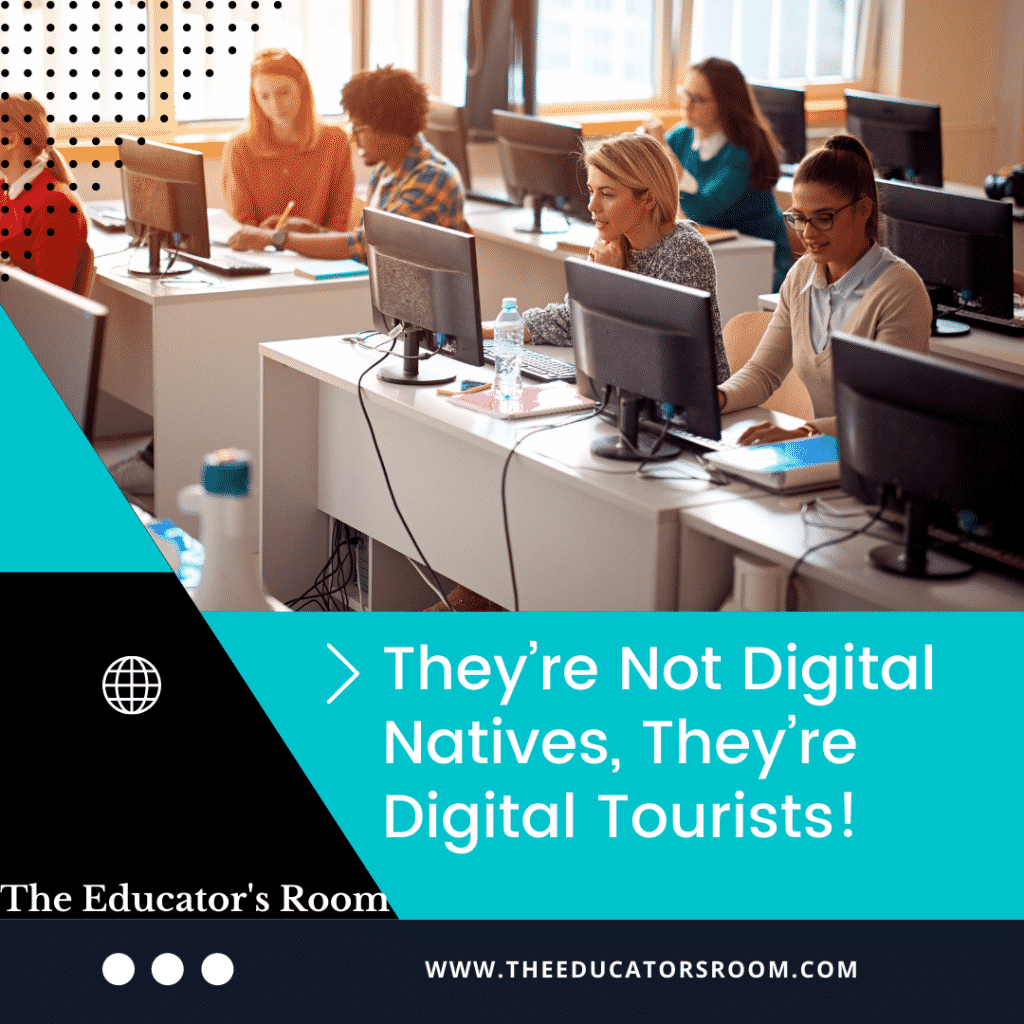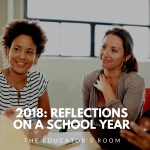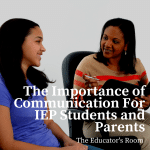To all those who claim that all students today are digital “natives,” I beg to disagree.
Digital natives are defined as those people who have grown up using technology daily beginning in the 1960s, but the term is more commonly used to describe those born in the 21st Century. According to the PBS Frontline Website,
Digital Natives aged 12 to 24 spend 4.5 hours a day viewing screen media (TV, Internet, Internet video, mobile video), excluding games;
82 percent of seventh- to twelfth-graders “media multitask” while doing homework, e.g. IM, TV, Web surfing, etc.
The NYTimes 2010 article, “If Your Kids Are Awake, They’re Probably Online” discusses the use of digital devices stating, “Those ages 8 to 18 spend more than seven and a half hours a day with such devices.” Certainly, use by our students has increased since then.
Despite these statistics, I am convinced that many students are not digital “natives,” they are digital “tourists.” Really bad tourists. I’m talking the “standing in line to see the Mona Lisa on the busiest day of the year and then leaving the Louvre once they saw it” kind of tourist. The “only want to eat at McDonald’s in a foreign country because I don’t like food, I don’t recognize” kind of tourist. The “I have no idea what kind of money this is” kind of tourist. In other words, bad tourists.
This past year was an eye-opening experience with my bad tourists. There was a 1:1 integration of students to netbooks in the English and selected Social Studies classrooms. Initially, members of my department and I were nervous about how we would need to keep up with what we imagined would be an onslaught of tech-savvy teens. We prepared ourselves by practicing various software platforms that we thought would be used successfully. We played with Google Docs, Edmodo, Edublog, WordPress, Blogger, PBWorks, Twitter, and Quizlet. We reviewed presentation software: Prezi, Animoto, Glogster, Voice Thread. We made decisions as to how to integrate these platforms gradually and at various grade levels to help us, transition students, to a paperless classroom. We imagined our classrooms would be full of students investigating and testing which software would best suit their needs. We were ready for the digital natives to collaborate and teach us about this “undiscovered country” of educational opportunities.
Instead, what we discovered was that many of our students were reluctant to try new platforms that differed even slightly in organization or layout. A login in a different location was perplexing; an embed code or link could not be located. We found our students were not naturally tech-savvy, save the requisite number of computer geeks per class. They did not want to move out of their comfort zone in technology, partly because they knew that work was involved, but, in fairness, partly because they were intimidated.
For example, in every class, a few students would have problems logging on.
“It’s still loading, Mrs. B.” says Student A
“Did you try shutting down and starting up again like I showed you last week?” I respond.
“No,” a flat statement.
I sigh.
Of course not. Student A who knows how to quickly log on to her computer at home to check Tumblr and Facebook considers this contraption on her desk as a foreign object. She is a digital tourist waiting hours online for the same roller coaster ride she rode on yesterday.
There were always problems with the software.
“Google Docs isn’t showing my changes,” says Student B
“Are you using Firefox or Google Chrome as a browser?” I respond.
I see a glazed look. He is a digital tourist who is having a hard time with trying alternate routes in a foreign city without asking directions.
“No,” a flat statement.
I sigh, again.
They failed to save word documents, adjust file extensions, and rarely took advantage of the spell-check or grammar check functions. And they were always losing their passwords….their “passports” onto websites. They acted as though we had co-opted their toys for unnecessary purposes.
In retrospect, I don’t blame them entirely for their hesitation in traveling through unfamiliar digital territory. Because of their proficiency with social media, there is an expectation that all students attending school today, at any grade level, are endowed by their creator with a new strain of technology-enhanced DNA. Because they can operate a joystick or the Wii remote with grace and ease, they are expected to come pre-familiarized with keyboard commands that would make them more productive (“What do you mean ‘Paste Special’? What’s unformatted text, anyway?”) Our anticipation that our students are capable with all things digital has led a combined sense of frustration.
That is not to say, however, that students can return home to the land of the pen, pencil, and worksheet. They need to be traveling on this Internet highway, but our digital “natives” need to stop acting like reluctant tourists safely traveling on a prescribed tour bus that never ventures into TCP/IP’s backcountry. Educators have plenty of support in meeting newly adopted standards. There are a number of organizations that support the development of 21st Century skills-ISTE, 21st Century Partnership to name a few. Plus, this experience has prepared us for next year when our 1:1 initiative will be expanded.
I believe that our students need to break out of the Magic School Bus model of Internet exploration staffed by Ms. Frizzel, the contemporary Pied Piper, who could transport them effortlessly into new experiences. While Ms. Frizzel served as the elementary school expert in Outer Space exploration, the study of anatomy and physiology, and all things in underwater research, the magnitude of information and means to access that information on the Internet today far exceeds the abilities of one teacher, even a teacher with Ms. Frizzel’s infinite patience and wisdom.
A better model to adopt for our students as digital tourists is Rick Steve’s model, where “travel is a political act.” In this model, students travel the alternate routes for productivity and interact and collaborate with others using many different software “languages”. They may stumble in these challenging and unfamiliar digital locations, but they will benefit from this exposure to the strange and unknown. They just need to get over their xenophobia of new software platforms. They need to develop a sense of curiosity and adventure in order to make their visits on the Internet productive. To facilitate their exploration, educators need to stop assuming that students are comfortable in the digital world and deliberately force students into becoming explorers out of their comfort zones. We need to convince our students that the double-deckered tour bus playing the pre-recorded soundtrack will not make them independent learners whose future success depends on the ability to mingle and cooperate. We need to encourage each of them to become a digital “native” rather the digital “tourist” who cautiously picks his or her way through the Internet rather than be immersed in the 21st Century cultural experience.








what a great piece!
what a fitting and fruitful metaphor 🙂
This has also been my experience in year 9/10 classrooms. They are more consumers of media than creators and it takes some effort to keep students on task with some exceptions.
It feels like in my state that public schools are so scared of letting the kids of the leash that they can never truly become digital natives. Nearly everything on the internet is blocked for reasons of "child protection" which is noble, but misguided. It makes it very hard to teach and even harder to learn.
I agree, but I think there is building pressure to make the Internet accessible, especially with the Common Core advocating its use. I wrote about how my district unblocked the Internet in http://usedbooksinclass.com/2013/02/16/once-you-g…
But, the students still are tourists in the best situations.